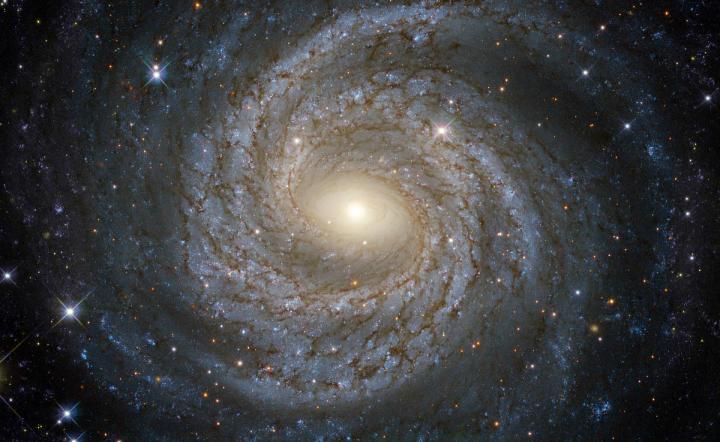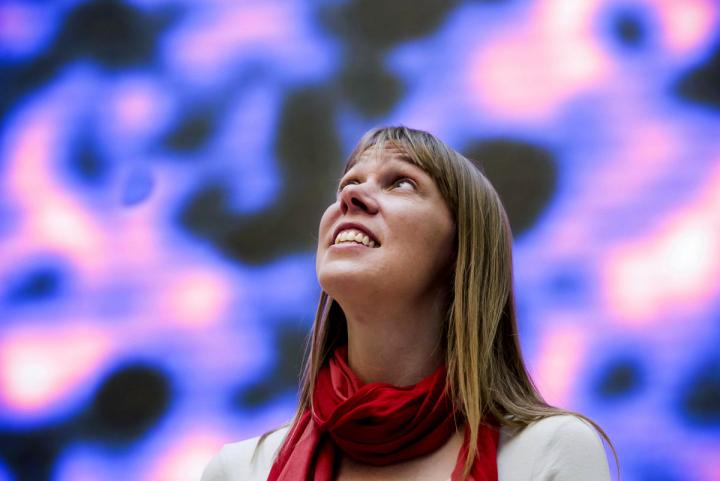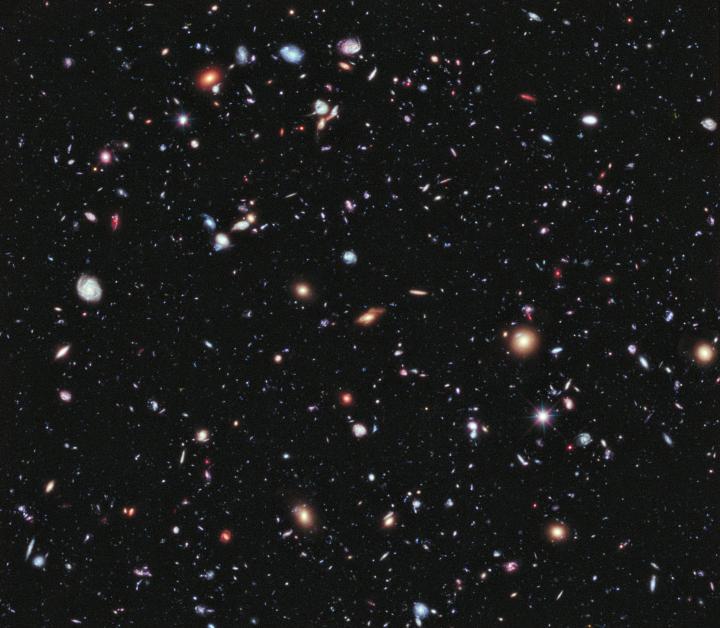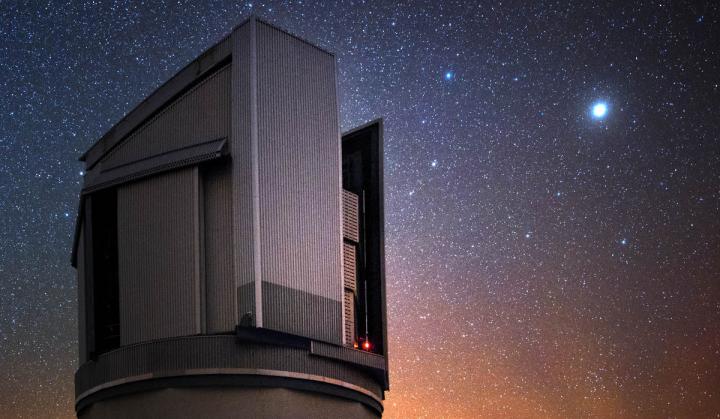Out of this world
Professor Catherine Heymans on understanding the universe and the need for more young scientists.

We only understand five per cent of the universe, according to leading astrophysicist at the University, Professor Catherine Heymans, who studies the enigmatic energy and matter that make up the other 95 per cent. Here she muses on the dark side of the cosmos and shares her hopes for a world where more young scientists are encouraged to solve its mysteries.
By Professor Catherine Heyman
Right from an early age I knew I wanted to explore the cosmos – the great unknown. What still amazes me today is the sheer scale of it all – the essential infinite enormity – contrasted with the realisation that at one point, in the very distant past, everything we can see was located in the same place in space and time. You may not have realised it yet, but we’re really highly insignificant in the grand scheme of things – just one out of seven billion people on planet Earth, orbiting just one star out of 100 billion stars in our Milky Way galaxy, just one galaxy out of 100 billion galaxies in our observable universe.
The sky is not the limit
Our universe is likely just one universe in an almost infinite number of universes where everything can and will happen. These ideas excite everyone, young and old, female and male. So what is the reason women make up less than 21 per cent of the scientific workforce in the UK? The reason less than a third of PhD science students are female? The reason why less than 10 per cent of physics professors in the UK are female? As one of the youngest female physics professors in the country, I fear the answer to this question is that we, as women, have made it so.
We simply don’t understand 95 per cent of our universe. Now you can view this as a major failing of scientists, or an amazing opportunity for future scientists.
Have you ever helped a niece, cousin or daughter with her homework? When they are struggling to read, you’ll patiently sound out the letters together. When they are battling with their spelling and writing, uncomplaining you’ll calmly show them how. But when it comes to tears over numbers, maths and science, so many of us will reply: “Oh I shouldn’t worry about that, love, it’s something I could never do either.” Mothers, grandmothers, aunts and cousins, the most important female role models in the lives of young girls, are telling them from a very early age that science is too hard and not for them. This well-established cultural perception of science is at the root of why in the UK only 20 per cent of girls choose to study physics at A level. No matter how many schools I visit and children I talk to, I can’t change this ingrained view.

I’m writing this article to tell you, the role models of all future bright sparks, that science isn’t any harder than other subjects. Science is utterly awesome and absolutely for everyone.
What the world needs now is more young scientists. The more we can train, the more technological innovation and advances you will see in the future. We need all children to embrace and enjoy science and technology, so the next time you see a young girl, or boy, struggling with their maths homework, don’t tell them to give up. Step in and calmly work it through together. Show them that science is just like any other subject: challenging, exciting, and definitely something that she or he can and will learn.
Delving into the dark side

This breathtaking image reveals a zoo of different brightly coloured galaxies.
The deepest ever photo of the universe was taken by the Hubble Space Telescope. Hubble orbits the Earth once every 97 minutes only 350 miles above the Earth’s surface. For a total of two weeks, Hubble stared at one tiny patch of sky catching the light from galaxies that are so far away their light has taken more than 13 billion years to travel to Earth. This breathtaking image reveals a zoo of different brightly coloured galaxies. Some are swirling blue spirals like our own Milky Way. Others are giant red galaxies that weigh more than a thousand trillion trillion trillion tonnes. The universe that we can see is immense, diverse and astonishingly beautiful. However, it may surprise you to learn that all of the stuff that we can see makes up less than five per cent of the universe.
I’ll make a bit of a confession now. Physicists understand the five per cent that we can see really quite well. We know all about atoms, quarks, bosons, all the tiny particles that make humans humans, planets planets and stars stars. For the other 95 per cent, however, the mysterious unknown stuff that we call ‘the dark side’, we haven’t a clue – we simply don’t understand 95 per cent of our universe. Now you can view this as a major failing of scientists, or an amazing opportunity for future scientists. When you’re missing a piece of key information that enormous, it surely means that a major breakthrough in our understanding of the world around us must be just around the corner.
The effect of dark matter
There are two entities on the dark side. The first is called dark matter, a mysterious type of particle that you can’t see or touch, but that we know is there because of the effects that it has on the things that we can see. Take our own Milky Way galaxy as an example. If it didn’t live inside a massive clump of invisible dark matter, the stars that are currently spiralling around in our galaxy would simply fly out into space. The gravity of dark matter is needed to kind of ‘glue’ it all together.
But if our galaxy lives inside a clump of invisible dark matter, then that means there must be some of it right now in your house. Focus your eyes for a brief moment on the tip of your nose. In that second, more than a million dark matter particles passed through your nostrils – but you can’t feel them because the type of particles that you are made up of are completely oblivious to their dark cousins.
Fact or fiction? On the matter of dark matter, I’m betting on this being fact. Particle physicists are trying to catch one of these elusive particles in deep underground lairs with massive vats of liquid xenon. They are also trying to create them by smashing particles together in highly energetic collisions in a 27-kilometre-long particle accelerator, CERN’s Large Hadron Collider. It can only be a matter of time before a major discovery is announced, I hope. On the matter of dark energy, our second component on the dark side, I’m less sure, however.

The power of dark energy
Our universe was created in a Big Bang 13.8 billion years ago and it has been expanding ever since. When I started studying astrophysics, I delighted in the idea that, one day, our universe would cease to expand, collapsing back in on itself in one giant explosive crunch. This explosion would seed a new Big Bang, and a beautiful birth-rebirth cycle would be born that matched my Buddhist philosophy of the time. My vision was shattered, though, with the discovery in the late 90s that the expansion of our universe wasn’t slowing down at all. Indeed, it was getting faster and faster each and every day. Far from a fiery rebirth, our universe was doomed to a cold empty death once the stars had burnt away the last of their fuel.
What could be causing the expansion of our universe to speed up? Well the simplest explanation for this phenomenon is very strange indeed. In the universe there are huge regions of nothingness: pure emptiness where there are no galaxies, no stars, no dark matter. Here there is nothing but ‘virtual particles’ that can simply pop into existence, providing an extra energy source – a ‘dark energy’ – to power the accelerating inflation of our universe. Fact or fiction? Well, fact to some extent, as this weird quantum phenomenon has been measured in a laboratory. But these quantum theories predict that a long time ago our universe should have expanded so rapidly that planets, stars and galaxies should never have even formed. As we’re very much here, there is something clearly wrong with this theory! It’s my day job to come up with a better explanation.
A job that’s out of this world
In the Atacama Desert in northern Chile, you’ll find one of the driest places in the world, home of the European Southern Observatory. When the weather is at its very best, we take deep images of the universe spanning about 1/30th of the sky.

In what other career do you get to seek daily the answer to mind-blowing questions like “Why do we even exist?” and travel around the world to exotic locations? In the Atacama Desert in northern Chile, you’ll find one of the driest places in the world, home of the European Southern Observatory. Our telescope, called the VLT (Very Large Telescope) Survey Telescope, or VST for short, is just one of a number of VLTs in the observatory, sited on the peak of the Cerro Paranal mountain, 2,635 metres above sea level. When the weather is at its very best, we take deep images of the universe spanning about 1/30th of the sky.
We’re now in our sixth year of observations, producing exquisite images that we use to map out the invisible dark matter and test the many different theories that exist for the origin of the dark energy. My team of researchers at the University of Edinburgh are focused on using these observations to test the potentially far-out idea that we need to go beyond Einstein with our current theory of gravity. It could be that our inference that there is a mysterious dark side to the universe is just a consequence of our poor understanding of gravity – maybe Einstein didn’t get it all right. It’s certainly exciting to be able to check.
Watch
Watch a Tedx talk by Professor Heymans.
Please note, this is a third-party video. If subtitles are needed, these can be turned on in YouTube settings.
About Professor Catherine Heymans
Professor Catherine Heymans is Professor of Astrophysics and European Research Council Fellow at the University. In 2018 she became the first winner of the new Max Planck-Humboldt Research Award worth €1.5 million to continue her dark energy research.

